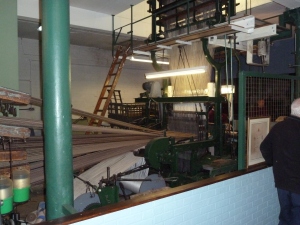On Tuesday 17th February I went to the Calderdale Industrial Museum in Halifax, West Yorkshire. Nothing extraordinary about a trip to a museum you might think, but the Calderdale Industrial Museum is different to other museums. The museum only started opening again last year after closing its doors to the public around 2000/01. Even now it only opens three or four times a year due to funding constraints and being staffed entirely by volunteers.
But this also makes it enchanting, mystical even. And this is because the museum at the moment is stuck in a time warp. Everything is as it was fourteen years ago, the signs, the machines even down to a jacket hung up on a wall. But what hits you most is the smell. The thought of fourteen years of grease, oil, soap and metal might sound disgusting to some people but to me it is so evocative, it fires up the senses and the smells turn into images and the imagination is set alight.
Why? Picture the men who made these amazing machines from a solid block of iron or steel weighing several tons or just a few pounds. These blocks of iron would be fashioned into lathes 50 feet long, drills 10 feet tall, multi-coloured weaving looms, machines that can turn reduce steel from 4 inches to 1 millimetre and something so intricate and delicate it is a true wonder of the industrial age. And all it does is make a staple!
And what of the men, women and children who worked these machines? Men, women and children who would rise before the dawn chorus so that they wouldn’t be late for work and have to go through the special gate just for latecomers. Who would work for 12 hours or more in conditions that would leave their senses dulled by the noise, the lack of light, the dirt and grime they breathed into their lungs and having to keep up with this new machinery that moved as faster than a bird diving for prey hour after hour after hour all day, every day.
And what happened if one of them should fall asleep at their machine or miscalculate the speed of the iron arm going back and forth at 10,000 rpm or more? At worse they might lose a finger, a toe an arm or a leg. At worse they would be killed as they tried to earn a pittance to survive. If they were injured and became too ill or disabled to work they would be cast into the street to beg and steal to live.
It is their lives and deaths I smell as I wander round the museum, the blood, sweat and tears they split everyday onto the wooden floors, the relief at another day over without injury and some money to feed the hungry mouths at home or the cries of pain as a finger was lost in a split second and their life was changed forever. And these smells transform themselves beyond the machines sat there silent but gleaming in all their splendour for the descendants of the workers to admire in awe and wonder. The smells transform into a fully working factory with all the sensory experiences you would have lived through then.
The Calderdale Industrial Museum evokes all this and much more because of what it is in an age of metal boxes. A true step back in time to an era that we should not forget nor sugar coat in a romantic sheen. But experience and understand it for what it is, what it was and what it stands for today.








